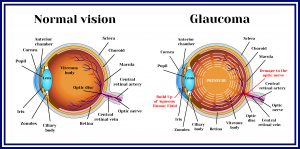In case you have already tried treating glaucoma with marijuana (be it medical or not), you may have noticed both some positive and negative effects. Indeed, this matter is not as black and white as one could hope for. While cannabis is generally praised for its numerous benefits when it comes to treating chronic pain, depression, anxiety and sleeping disorders, for example, curing glaucoma with cannabis has yet to come to its full potential. So, let’s see what happens here exactly.
First of all, let’s deal with the very nature of the disease. Glaucoma is a disease of the optic nerve (the nerve connecting the eye to the brain) which causes decreased peripheral vision and can eventually lead to complete and irreversible blindness. In the US alone, over 2.7 million people aged 40 or older are suffering from the disease, while some forecasts by the Glaucoma Research Foundation predict the number will rise to four million by 2030. Either way, the matter is extremely serious, especially due to the fact that the illness is usually not recognized until some permanent damage has been done. High eye pressure acts as the most common trigger for most types of glaucoma, so that was the starting point for cannabis related research and experiments.
Another reason why some natural alternatives such as cannabis are being investigated is the fact that neither existing treatment method is perfect. For instance, eye drops are the least invasive, yet have the most side effects such as itching, and even fatigue. Pills can interact with other drugs and require extra care. Surgery is definitely the most invasive, and, sadly, its effects are not permanent. Therefore, let’s see what cannabis has to bring to the glaucoma table.
It has to be emphasized from the very beginning that cannabis comes in different forms and consists of various compounds, and they all affect glaucoma distinctively. Smoking marijuana is one of the possible treatments, but it has to be said it is the least recommendable due to its side effects. A study showed that despite lowering the intraocular pressure in patients, smoking cannabis was also decreasing the blood pressure and increasing the heart rate. Among other unfavorable effects there were drowsiness, slow reactions, euphoria and bad coordination. Consequently, smoking cannabis is not so recommendable.
However, the initial effect of lowering intraocular pressure (which is essential in glaucoma treatments) during marijuana smoking has encouraged further research of the plant, especially its THC and CBD substances. What is more, due to the fact that there are cannabinoid receptors inside the eye there is a fair possibility of cannabis compounds merging naturally with the receptors. It is our cannabinoid receptors which regulate the fluid level in the eye, so it is only logical that by affecting them in the most suitable way we could decrease the pressure and damage to the eye nerve (it is the extra fluid that causes high eye pressure).
This inspired further comparison between THC and CBD in glaucoma treatment, and they both have their advantages and disadvantages. While THC does lower the eye pressure, it also decreases the blood pressure within the eye, i.e. lowers the necessary blood supply to the eye. Particular THC products also have its strengths and weaknesses: the eye drops take too much time, and the impact of oral cannabis is hard to predict.
On the other hand, different doses of CBD make the eye pressure both high and low. CBD is already famous for its healing properties and the fact that it has fewer side effects compared to THC. For this reason, the ideal combination for the THC and CBD synergy is what would be the best solution in treating glaucoma.
To summarize, medical marijuana can definitely help patients struggling with glaucoma as it has plenty of advantages over the traditional methods. Still, more research is necessary in order to achieve the best results. In any case, the future is looking bright for glaucoma patients.
This article is intended for informational purposes only. If you have any questions or are considering any recommendations, please consult your health practitioner.























